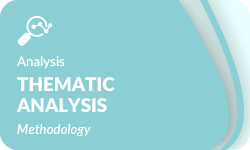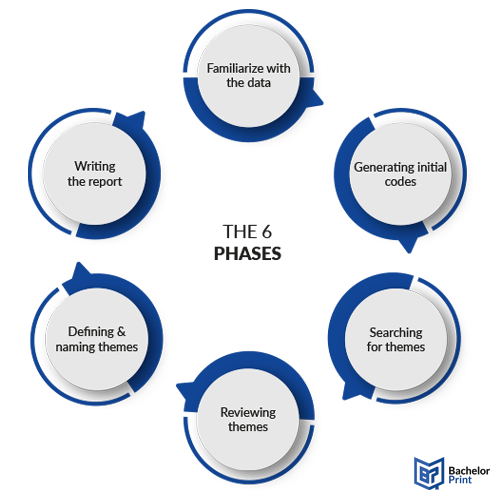
Thematic analysis is a qualitative research methodology that helps identify, analyse, and interpret patterns of meaning in data. It is especially popular among students working on bachelor’s, master’s, or doctoral projects because it offers a structured yet flexible way to make sense of interviews, focus groups, or written responses. This guide explains what thematic analysis is, when to use it, and how to apply it step-by-step.
Definition: Thematic analysis
Thematic analysis (TA) is a qualitative research method used to identify, analyse, and interpret recurring patterns or themes within data. First introduced by Virginia Braun and Victoria Clarke in 2006, it provides a structured yet flexible approach for exploring complex information.
Students often use this methodology because it’s accessible, works across various disciplines, and is suitable for projects of any size (from small bachelor’s theses to large doctoral dissertations).
➜ Use thematic analysis when your goal is to uncover patterns in qualitative data, such as interviews, focus groups, or open-ended survey responses.
Advantages & disadvantages
Thematic analysis comes with several strengths but also some limitations you should be aware of before choosing it for your project. The table below gives an overview:
✅ Advantages
❌ Disadvantages
Note: Thematic analysis is most useful when exploring experiences, opinions, and perceptions rather than testing measurable variables.
When should you use it?
Thematic analysis is one of the most versatile methods in qualitative research, making it a strong choice for many types of academic projects. It is particularly relevant when your goal is to understand participants’ experiences, views, or opinions and to identify patterns across a dataset.
You should consider using thematic analysis when:
- Handling large, complex datasets allows you to divide and organise data into clear, digestible categories.
- Analyzing subjective, experience-based data, such as exploring how students experience online learning.
- Expanding on established knowledge by structuring your analysis around predefined ideas or frameworks.
- Working on theses or dissertations at any level, especially if your research involves interviews, open-ended surveys, or focus groups.
- Exploring new or under-researched areas where you don’t want to impose rigid theoretical frameworks but instead allow themes to emerge naturally.
➜ Thematic analysis is the right choice when you want to go beyond simple “yes/no” answers and explore the deeper meanings behind participants’ words.
It allows you the flexibility to work inductively (letting themes emerge from the data) or deductively (guided by existing research), making it adaptable for a wide range of academic projects.
Approaches
Thematic analysis can be conducted in different ways depending on your research goal and theoretical stance. Two key distinctions are whether your analysis is inductive or deductive and whether it focuses on semantic or latent content. Often, studies use a hybrid of these approaches, combining elements from both sides.
Inductive approach
Inductive reasoning involves deriving themes directly from the data, without preconceived ideas. Essentially, you let the data speak for itself, allowing themes to emerge naturally. This approach is part of exploratory research and works best when there is little existing research on the topic or when you’re trying to discover new patterns or insights.
➜ The inductive approach is most suitable for exploratory research questions, where the aim is to uncover new insights into a topic.
Deductive approach
Deductive reasoning begins with a theoretical framework or pre-existing codes derived from existing theories or prior research. The researcher’s goal is to test or validate those existing concepts against new data, providing confirmation or contradiction.
➜ The deductive approach is ideal for confirmatory research questions, where you’re building on existing knowledge or testing established theories.
Semantic analysis
Semantic analysis focuses on the explicit content, what participants say directly or what is written. It’s a surface-level approach that describes the data as it appears. There’s little interpretation involved, and the analysis is objective, often identifying themes at face value.
Latent analysis
Latent analysis goes deeper into the underlying meanings and assumptions of the data. You examine not just what participants say, but why they say it and what hidden meanings may exist beneath the surface. This type of analysis involves interpretation and theorization based on the data.
Overview
This table highlights the difference between the two main approaches: inductive and deductive reasoning.
| Inductive | Deductive |
| Themes are derived directly from the data. | Themes are guided by existing theories or literature. |
| Useful for exploring new, under-researched topics. | Useful for expanding on established research. |
| Open-ended and flexible. | More structured and theory-driven. |
This table helps you understand the focus of thematic analysis at different levels of interpretation.
| Semantic | Latent |
| Focuses on explicit content (what participants say). | Examines underlying meanings and subtext. |
| Objective and surface-level. | Interpretive, deeper analysis. |
| Good for straightforward research questions. | Great for uncovering hidden narratives or assumptions. |
When to use which approach?
Your choice of inductive vs. deductive and semantic vs. latent will depend on the nature of your data and your research questions.

Inductive approach with latent analysis
Use when you want to explore new areas with a focus on the underlying meaning.

Deductive approach with semantic analysis
Use when you’re working with existing theories and looking for explicit patterns.
➜ Thematic analysis is flexible, but you must choose the approach that best fits your research goals and dataset. These decisions will shape how you interpret and report your findings.
The 6 phases
Thematic analysis is broken down into six key phases, each crucial for generating meaningful insights from qualitative data. Below is a step-by-step guide to each phase:

Phase 1: Familiarize with the data
Begin by immersing yourself in your dataset. Read through the data multiple times, taking initial notes and making sure to capture your first impressions. If the data was collected through interviews or focus groups, ensure accurate transcriptions (or transcribe them if needed).
➜ This phase is foundational because you cannot analyse the data effectively without first building an understanding of it. It helps you identify any preliminary patterns and prepares you for the next steps.
Note: Take reflexive notes about any initial assumptions or thoughts about the data, as these can influence later phases.
Phase 2: Generating initial codes
In this phase, you systematically go through the data and start labelling significant segments of it, turning them into codes. This can be done manually or using qualitative data analysis software like NVivo or MAXQDA.
➜ Coding breaks the data down into manageable chunks. It allows you to identify recurring concepts and makes it easier to group them into broader themes.
Note: Code as you go, keeping in mind that the codes should be flexible. You can always refine or merge them in later phases.
Phase 3: Searching for themes
Once you have codes, group related codes together into potential themes. This is where you start to identify broader patterns in your data that answer your research questions.
➜ Themes reflect the bigger picture of your analysis. They help you organise your data into a coherent narrative that aligns with your research focus.
Note: Use mind maps or thematic maps to visually organise codes and themes. This helps keep the process clear and organised .
Phase 4: Reviewing themes
Go through your themes and ensure they are coherent and distinct from one another. You may need to merge, split, or discard themes that don’t fit the data or the research question.
➜ This phase ensures that your themes represent the data accurately and that they work together to answer your research questions. This step is crucial for maintaining analytical rigor.
Note: Keep a reflexive journal during this phase to document any decisions you make about which themes to retain and which to discard.
Phase 5: Defining & naming themes
Refine the themes you’ve identified, giving them clear, concise names that accurately represent their content. Write detailed definitions for each theme, outlining what it includes and what it excludes.
➜ This phase is important for clarity. Clearly defining themes ensures your analysis is consistent and easy to follow for readers.
Note: Choose names for your themes that are descriptive but not too detailed. You want your theme names to be memorable and evocative.
Phase 6: Writing the report
The final phase involves writing a coherent narrative that integrates your themes and answers the research questions. This should include data extracts (quotes or examples) to support each theme and a clear interpretation of your findings.
➜ This is where you synthesize everything. The goal is to present your analysis in a way that’s engaging, transparent, and methodologically sound.
Note: Be mindful of balancing depth and clarity. Ensure your report is thorough, but avoid over-explaining. Readers should be able to follow the narrative easily.
➜ Don’t skip reflexivity. Always document your assumptions and decisions during coding.
Other qualitative methods
While thematic analysis is a widely used method, there are other qualitative approaches that might suit different research goals. The table below compares thematic analysis with other popular qualitative methods.
Method
Main goal
Sample size
Focus
Thematic analysis
Identify & interpret themes
Flexible
Meaning & context
Grounded theory
Build new theory
Moderate–large
Conceptual abstraction
Content analysis
Quantify & categorize
Large
Frequency & patterns
IPA (phenomenology)
Explore lived experience
Small
Deep personal insights
Common mistakes
Even experienced researchers can make mistakes during thematic analysis. Below are some common pitfalls and tips on how to avoid them.
❌ Not considering how your own biases or assumptions might influence the analysis.
❌ Stopping at surface-level descriptions instead of interpreting the deeper meanings.
❌ Creating too many fragmented codes that make it difficult to identify clear themes.
❌ Treating codes as themes rather than grouping codes into larger, meaningful themes.
Note: Always ask yourself, “Does this theme help answer my research question?” If not, refine or discard it.
in Your Thesis
Example
Here’s how Braun & Clarke’s 6 phases would look in practice using an interview-based study on student stress.
Now, let’s walk through each phase
➜ This phase helps the researcher get an initial sense of the data, allowing them to engage deeply with the material before jumping into coding and analysis.
➜ This is where the data is broken down into smaller pieces, making it manageable and allowing for systematic organisation .
➜ This phase helps identify the bigger picture: the emerging themes that capture the most important aspects of the data.
➜ Refining themes ensures that they are representative of the data and cohesive in addressing the research questions.
➜ Defining themes clearly ensures that the analysis is precise and consistent, making it easier to report and understand.
➜ The final report ties the themes to the research question, integrating data extracts (like quotes) and offering a clear interpretation of the findings.
Note: Always make sure your themes are directly linked to your research question. This ensures that your analysis remains focused and relevant.
FAQs
Thematic analysis is a qualitative research method used to identify, analyse, and interpret patterns or themes within data.
Begin by familiarising yourself with the data, then code the data, identify themes, review and refine them, and finally write a report linking themes to your research questions with supporting data.
Thematic analysis can be used within various methodologies, particularly qualitative research approaches like phenomenology, grounded theory, and ethnography.
The main focus of thematic analysis is to identify and interpret key themes or patterns within qualitative data to understand meaning and context.
- Familiarization with the data
- Generating initial codes
- Searching for themes
- Reviewing themes
- Defining and naming themes
- Writing the report